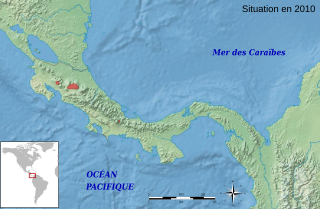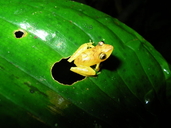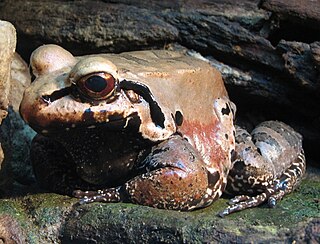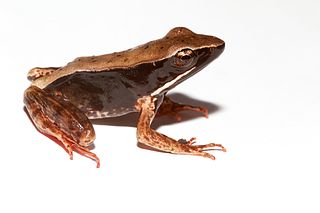Atelopus senex is an extinct species of toad in the family Bufonidae. It was endemic to Costa Rica and known from the Cordillera Central and Cordillera de Talamanca at elevations of 1,100–2,200 m (3,600–7,200 ft) asl.

Centrolene prosoblepon is a species of frog in the family Centrolenidae, commonly known as the emerald glass frog or Nicaragua giant glass frog. This species can be found in Ecuador, Colombia, Panama, Costa Rica, Nicaragua, and Honduras. Its natural habitats are lowland tropical forests and montane cloud forests. It is a nocturnal species occurring in low vegetation in mature forests only. It is not considered threatened overall by the IUCN although deforestation and pollution are potential threats, as is chytridiomycosis.

Cochranella euknemos, sometimes known as the San Jose Cochran frog, is a species of frog in the family Centrolenidae. It is found in central Costa Rica and south/eastward to Panama and to the western flank of the Cordillera Occidental in Colombia. Some Colombian records might apply to Cochranella mache.
Silverstoneia nubicola is a species of frog in the family Dendrobatidae. It is found in western Colombia, Panama, and southwestern Costa Rica.

Agalychnis saltator, also known as the parachuting red-eyed leaf frog and misfit leaf frog, is a species of frog in the subfamily Phyllomedusinae. It is found in the Caribbean lowlands from north-eastern Honduras to eastern-central Costa Rica at elevations of 15–1,300 m (49–4,265 ft) asl.

Agalychnis lemur, the lemur leaf frog or lemur frog, is a species of frog in the subfamily Phyllomedusinae. It is found in Costa Rica, Panama, and adjacent northwestern Colombia. It is classed as Critically Endangered and threatened by the fungal disease chytridiomycosis.

The narrow-lined tree frog is a species of frogs in the family Hylidae found in the mountains of Costa Rica and western Panama. Its natural habitats are humid lower montane rainforests. It is a nocturnal species that breeds in small puddles and water-filled depressions.
Isthmohyla debilis is a rare species of frog in the family Hylidae. It occurs in the Atlantic slopes of the Cordillera Central and Cordillera Talamanca in Costa Rica and western Panama as well as on the Pacific slopes in southwestern Panama. Common name Isla Bonita treefrog has been suggested for it.

Isthmohyla rivularis is a rare species of frog in the family Hylidae. It occurs in the cordilleras of Tilarán, Central, and Talamanca in Costa Rica as well as adjacent western Panama. The species was thought to already have become extinct, but in 2007, it was re-discovered in the Monteverde Cloud Forest of Costa Rica when a single male was found. In 2008, a gravid female and few males were spotted. The common name American Cinchona Plantation treefrog has been suggested for it.

Isthmohyla tica, also known as Starrett's treefrog, is a species of frog in the family Hylidae. It is found in the Cordillera de Tilarán, Cordillera Central, and Cordillera de Talamanca of Costa Rica and western Panama. The specific name tica is derived from the name that Costa Ricans use to refer themselves, tico.

The Panama cross-banded tree frog or pug-nosed tree frog is a species of frog in the family Hylidae found in the humid Pacific lowlands of southwestern Costa Rica to eastern Panama and in the Caribbean lowlands of Panama and northern Colombia. Males of the species utilize synchronous calling to hide their position from predators. Females create basins during amplexus and deposit fertilized eggs onto the surface of the water.
Craugastor andi is a species of rain frog in the family Craugastoridae which has not been seen since 1990. It is found in the Caribbean drainage of Costa Rica in the mountains and hills of the Cordillera Central and the far northeastern Cordillera de Talamanca, and in extreme northwestern Panama. Frank and Ramus (1995) give it the vernacular name Atlantic robber frog. It is known locally in Spanish by the generic names, used for many species, of rana de hojarasca, ranita or sapito.
Craugastor obesus is a species of frog in the family Craugastoridae. It is found in the Caribbean slopes of southeastern Costa Rica and western Panama. Its natural habitats are lowland moist forest, premontane and lower montane wet forest and rainforest. It can be found in the spray zone on rocks, boulders, and cliff faces in the middle of moderate-sized cascading streams.
Craugastor rayo, also known as the Sabana robber frog, is a species of frog in the family Craugastoridae. It is endemic to the Cordillera de Talamanca, Costa Rica.

Craugastor taurus is a species of frog in the family Craugastoridae. It is found in the Golfo Dulce region of southern Costa Rica and adjacent western Panama. It is sometimes known as the Golfito robber frog.
Pristimantis altae, also known as mountain robber frog, is a species of rain frog in the family Strabomantidae with a bright coral-coloured groin. It is found in Costa Rica and Panama.

Pristimantis caryophyllaceus is a species of frog in the family Strabomantidae. It is found in Costa Rica and Panama; records from Colombia prior to 2010 refer to Pristimantis educatoris. However, taxonomy of Pristimantis caryophyllaceus and P. educatoris remain unsettled, and many sources continue to report Pristimantis caryophyllaceus from Colombia.

The smoky jungle frog is a species of frog in the family Leptodactylidae. It is found in Bolivia, Brazil, Colombia, Ecuador, Costa Rica, Panama, French Guiana, and Peru. Its natural habitats are tropical and subtropical moist broadleaf forests, subtropical or tropical swamps, subtropical or tropical moist montane forest, rivers, freshwater marshes, intermittent freshwater marshes, and aquaculture ponds.

The Peralta frog, or montane leopard frog, Lithobates taylori, is a species of frog in the family Ranidae found in Costa Rica and Nicaragua.

Warszewitsch's frog is a species of frog in the family Ranidae found in Honduras, Nicaragua, Costa Rica, and Panama.













